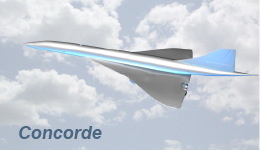|
Sound travels at 343 m/s (767 mph) in air at 20ºC and atmospheric pressure. Sound travels faster than most water waves but far slower than light waves. By comparison, sound is faster than all forms of human transportation except a few high-performance aircraft and rockets. Passenger jets typically travel at speeds of 550 mph or less. 
|
The speed of sound is the product of frequency and wavelength, similar to other waves. With sound, this equations is most often applied to calculate frequency or wavelength of sound in air by assuming that the speed is 343 m/s. 
|
| (16.1) | | | v | = | speed of sound = 343 m/s at sea level and 21ºC | | f | = | frequency (Hz) | | λ | = | wavelength (m) |
| Speed of sound
|
|
What is the frequency of sound that has a wavelength of 0.5 m?
| Asked: | frequency f | | Given: | λ = 0.5 m; assume v = 343 m/s | | Relationships: | v = fλ | | Solution: | | v = fλ → f = v /λ | = | (343 m/s) ÷ (0.5 m) | | | = | 686 Hz | | | Answer: | The frequency is 686 Hz. | 
|
Supersonic describes motion at speeds greater than the speed of sound. Many military jets are capable of supersonic flight, as are most rockets. No passenger jets currently flying, however, are capable of supersonic flight. This is because the aerodynamics required for stable supersonic flight is different from that required for subsonic flight. The reason has to do with the shock wave that forms at the nose and leading edges of a supersonic aircraft. 
|

|
 The pressure change across the shock wave causes a very loud sound known as a sonic boom. The shock wave can create severe turbulence that may make an aircraft unstable. It also takes a great deal of power to push through the atmosphere at supersonic speeds. Air travelers have been unwilling to pay the price, and the last supersonic passenger jet, the Concorde, was retired in 2003.
The pressure change across the shock wave causes a very loud sound known as a sonic boom. The shock wave can create severe turbulence that may make an aircraft unstable. It also takes a great deal of power to push through the atmosphere at supersonic speeds. Air travelers have been unwilling to pay the price, and the last supersonic passenger jet, the Concorde, was retired in 2003. 
|

